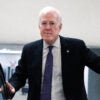A dangerous “us versus them” attitude is festering in Washington these days.
It’s not surprising with headlines about congressional Democrats and party officials expressing an “anti-Trump all the time” strategy.
The media is stoking the perception that Washington is riven by divisions about to boil over. The New York Times had a recent front-page article called “Civil Servants Sense ‘Dread’ in Trump Era: Frustration is stirring talk of resistance.”
The Daily Signal depends on the support of readers like you. Donate now
The writer interviewed a dozen people allegedly terrified of what the new administration plans to do. The reporters grudgingly note, “Federal workers are more likely to be Democrats,” but then they dive back into the interviews with employees from the State Department, the Environmental Protection Agency, and other agencies and functional divisions like the Digital Service, a group led by a former Google engineer recruited to save the Obama administration’s health care website.
It would be a mistake, however, for the newly appointed Cabinet members to believe this attitude is all pervasive and carry that expectation into their new positions.
Buried in the Times article is the admission, “Some federal workers welcome Mr. [Donald] Trump’s promises to create new jobs, build infrastructure, and lower taxes. Others say they are focusing on doing their jobs and trying not to be distracted by the political noise that surrounds them.”
It’s no surprise that those employees didn’t get extended personal quotes or pictures (like the Digital Service head.)
I know that the kinds of employees who will welcome the newcomers or are just doing their jobs exist, because I’ve experienced it three times.
When President Ronald Reagan came into office after President Jimmy Carter, James Miller III was dispatched to the Federal Trade Commission after a stint at the Office of Management and Budget. The FTC is made up of almost all career staffers—mostly lawyers and economists—and the Carter years at the FTC rivaled the Obama years in pursuing far-reaching regulations.
As just one example of the agency’s audacity, it charged the makers of Clairol with deceptive advertising for stating that their hair color was permanent. The commission complained that the hair coloring did not change the color of new hair that grew in, thus making the advertising deceptive.
Once established as chairman of the FTC, Miller and his senior staff realized they needed to mount an aggressive effort to explain why such mindless regulations and a blizzard of lawsuits were not just bad for business—they squelched competition, innovation, and job growth.
But there was little appetite for such a conversation within D.C., which meant it was time for them to leave.
At any department or agency, while there may be ideologues who want the new administration to fail, there are also employees like the ones in that buried paragraph of the New York Times piece.
While we hear the horror stories of the lazy, useless, hostile civil servant, there are far more dedicated, competent people with deep knowledge of their issues and mission. It’s important to create an atmosphere where those people feel they can make a contribution.
To regain the trust of American businesses, the FTC decided to expand its speakers bureau and deployed messengers from D.C. and the regional offices to any local chamber of commerce, civic group, or other organization that was willing to give them a forum.
(Rod Paige, then-secretary of education, had us set up a similarly expansive effort, and Ambassador James Nicholson, secretary of veterans affairs, began the process, both under President George W. Bush’s administration.)
Leading by Example
The most effective way to initiate the effort, which can mean the difference between success and failure, is for the department leadership, the secretary, and political appointees to demonstrate how to deliver the message.
This means including storytelling, humor, visuals, and other advanced presentation elements. It means rehearsal. And, as noted above, it means initially focusing on the internal audience.
Be prepared for staff to be skeptical. Acting EPA Administrator Catherine McCabe recently tried to reassure employees that the report that scientific data on climate change had been deleted from EPA websites was untrue. Her comments didn’t stop some employees from doubting and saying so on social media.
Next, participation has to be totally voluntary. Participants need to see the program as an opportunity for professional and skills development.
This requires training as well as help developing and packaging material. This effort fails if employees think they are being told to spout a party line. It succeeds if they are putting material together in which they truly believe.
When we set up the program at the FTC, participants initially thought they were completely prepared because they knew their subject matter. One lawyer told me, “I can cover the Hart-Scott-Rodino process in just an hour.”
I explained that the goal was to talk for about 10 to 15 minutes in a highly interactive manner and to inspire confidence.
Third, the program has to be transparent, and that means it will draw criticism. Shrug it off.
Harnessing the Power of Social Media
Finally, consider an enhanced role for social media in pushing your agency’s message.
Has social media replaced outreach and the speakers bureau? No, and it never will. There is no substitute to showing up in person to talk to people, answer questions, respond to criticism, and pitch the need for support.
However, social media can enhance the impact of these events. Every group has its own website with video capability, and its own publications in hard copy and electronic format. Most are also on Twitter, Instagram, and post speaker excerpts on YouTube and increasingly are using Facebook Live.
Accept an invitation to appear at an event, and these channels will promote your speaker before the event. The local group probably has decent ties to local media, too.
During the speech, attendees will tweet about what your speaker says and pictures snapped during and after the event will get posted on a variety of sites. The organization’s website will carry the “news” of the event.
The 2016 election may be over, but the campaign to regain public understanding and trust in government is just beginning.





























